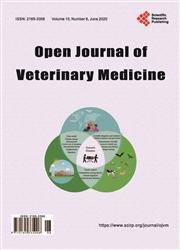The Effect of Delivery Method on the Pharmacokinetic Properties of Meloxicam in Pre-Weaned Dairy Calves with Diarrhea
引用次数: 6
Abstract
The non-steroidal anti-inflammatory drug meloxicam is commonly used as adjunct therapy for neonatal calf diarrhea to control pain and inflammation. The objective of this study was to compare the pharmacokinetics of meloxicam in diarrheic pre-ruminant dairy calves dosed either orally or subcutaneously. Twelve pre-ruminant male dairy calves with mild to moderate diarrhea were randomly assigned to receive one of four treatments (three per group): subcutaneous meloxicam (SM, 0.5 mg/kg body weight); an oral bolus meloxicam suspension (OM, 1 mg/kg body weight); an oral meloxicam suspension added to a feeding of oral electrolytes (EM, 1 mg/kg body weight); and an oral meloxicam suspension added to a feeding of milk replacer (MM, 1 mg/kg body weight). The predicted pharmacokinetic parameters for OM, MM, EM, and SM groups were: half-life (56.8 ± 21.7 vs. 136.0 ± 26.6 vs. 85.2 ± 21.7 vs. 36.3 ± 21.7 h), Cmax (4.3 ± 0.4 vs. 3.7 ± 0.4 vs. 3.9 ± 0.4 vs. 2.1 ± 0.4 μg/mL), Tmax (13.3 ± 4.0 vs. 10.7 ± 4.0 vs. 13.3 ± 4.0 vs. 2.7 ± 4.0 h), and AUC0-∞ (383.4 ± 126.8 vs. 877.8 ± 155.3 vs. 457.1 ± 126.8 vs. 126.4 ± 126.8 h * μg/mL). Oral meloxicam, especially MM, had extended elimination phases relative to SM. All meloxicam therapies provided effective therapeutic levels but all oral therapies (1 mg/kg) provided longer durations of activity than injectable meloxicam (0.5 mg/kg).给药方式对美洛昔康在断奶前腹泻小牛体内药代动力学特性的影响
非甾体类抗炎药美洛昔康通常用于新生儿小牛腹泻的辅助治疗,以控制疼痛和炎症。本研究的目的是比较口服或皮下给药的美洛昔康在腹泻的反刍前奶牛犊牛中的药代动力学。试验选取12头患有轻度至中度腹泻的前反刍雄性犊牛,随机分为4组(每组3组):皮下注射美洛昔康(SM, 0.5 mg/kg体重);口服美洛昔康混悬液(OM, 1mg /kg体重);在口服电解质中加入口服美洛昔康混悬液(EM, 1 mg/kg体重);口服美洛昔康混悬液,添加到代乳饲料中(MM, 1mg /kg体重)。预测的药代动力学参数OM,嗯,哦,和SM组:半衰期(56.8±21.7和136.0±26.6和85.2±21.7和36.3±21.7 h), Cmax(4.3±0.4和3.7±0.4和3.9±0.4和2.1±0.4μg / mL),最高温度(13.3±4.0和10.7±4.0和13.3±4.0和2.7±4.0 h),和AUC0 -∞(383.4±126.8和877.8±155.3和457.1±126.8和126.4±126.8 h *μg / mL)。口服美洛昔康,尤其是MM,相对于SM有更长的消除期。所有的美洛昔康疗法都提供了有效的治疗水平,但所有口服疗法(1mg /kg)比注射美洛昔康(0.5 mg/kg)的活性持续时间更长。
本文章由计算机程序翻译,如有差异,请以英文原文为准。
求助全文
约1分钟内获得全文
求助全文

 求助内容:
求助内容: 应助结果提醒方式:
应助结果提醒方式:


